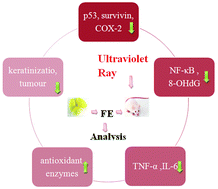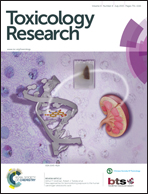Inhibition of the flavonoid extract from silkworm cocoons on DMBA/UVB-induced skin damage and tumor promotion in BALB/c mice
Abstract
Exposure of the skin to ultraviolet B radiation causes oxidative stress that results in sunburn, photoaging, and skin cancer. We aimed to investigate the antioxidant, anti-inflammatory, and anticancer effects of a flavonoid extract (FE) from the sericin layer of Daizo silkworm cocoons. The analytical HPLC results showed that the FE of the Daizo cocoon shell contains the flavonoid aglycones quercetin (21.76 ± 0.66 g kg−1 FE) and kaempferol (4.62 ± 0.11 g kg−1 FE). In a skin tumour mouse model, the topical application of FE reduced the number of tumours per mouse from 5.1 in the model group to 3.2 and 2.6 in two sample groups (3 mg and 5 mg FE) prior to induction with UVB/DMBA. Our in vivo experimental results also showed that the FE could reduce the phototoxicity of UVB at different cellular and molecular levels by decreasing the severity of dermal inflammation and keratinocyte proliferation through the modulation of oxidative stress and NF-κB. FE could increase antioxidase activity and decrease the levels of the inflammatory cytokines IL6 and TNF-α. These results suggest that the flavonoid extract mainly consisting of flavonoid aglycones might be a potential candidate for anti-cancer drugs in the prevention and treatment of skin cancer. This study has profound significance for the comprehensive utilization of silkworm cocoon.


 Please wait while we load your content...
Please wait while we load your content...